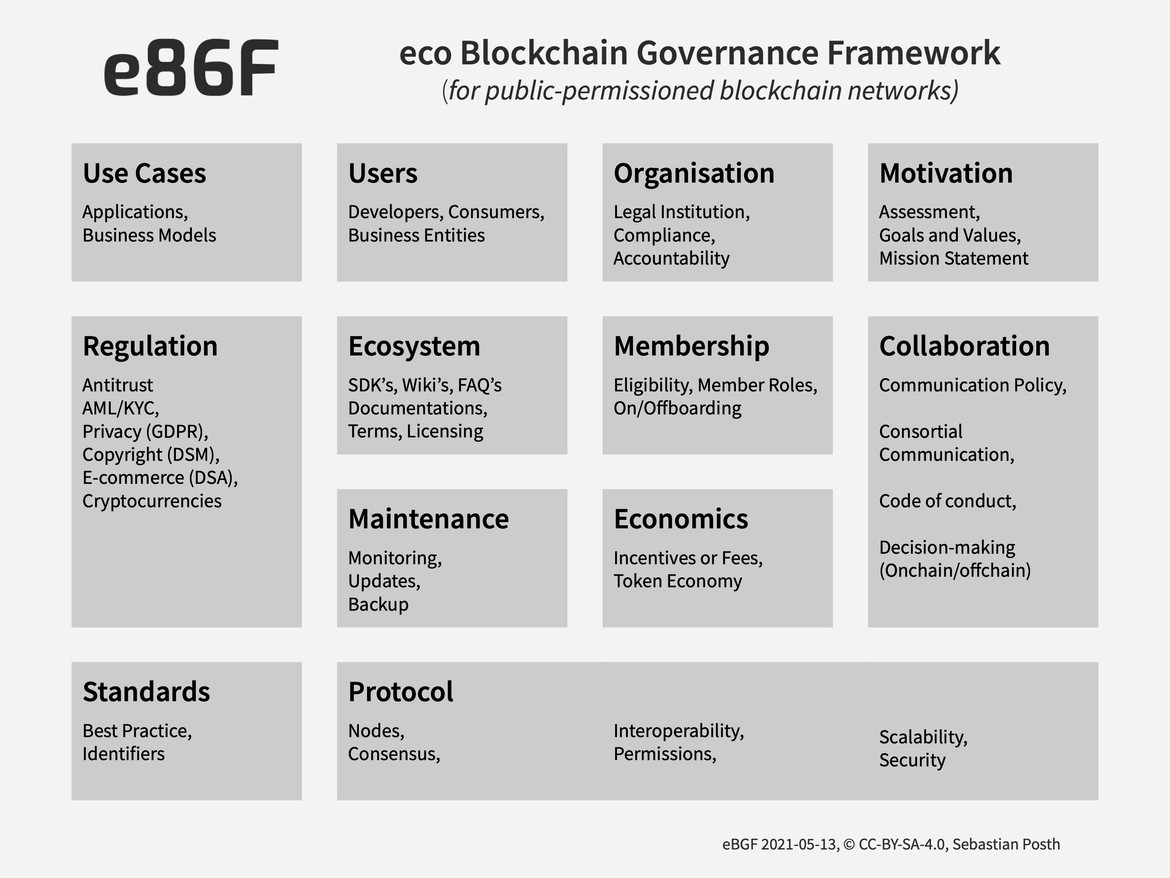The eco Blockchain Governance Framework – eBGF
Prof. Norbert Pohlmann & the team from if(is) explain how eco’s Governance Framework creates a root of trust for the operation of a consortial blockchain.

© ismagilov | istockphoto.com
There is a growing interest in blockchain technology in various industries and sectors. Blockchains can be described as a network of distributed nodes that guarantee the authenticity, origin, and integrity of transactions and persistence of data without the need to trust only one centralized authority or service provider.
Decentralized trust
Blockchains can be used by companies to collaborate and can create decentralized trust. This means that multiple parties can work together without a central root of trust. Blockchain technology provides a shared infrastructure among all organizations, while at the same time, participants of the network can still compete on the various marketplaces with their applications, services, and products.
A large number of innovative applications in the banking sector and fintech have been created based on the immutability, trust, and transparency of public-permissionless blockchains like Bitcoin or Ethereum. With public-permissioned blockchains, however, companies can make use of the advantages of public-permissionless blockchains with more control over the set-up and rules of the network. Current fields are, for example, in the areas of logistics and self-sovereign identity.
What are the advantages of consortial blockchains?
Consortial blockchains can be defined as public-permissioned blockchain networks that are institutionalized by a set of entities – which can be companies, organizations, or governments – who participate in various roles with different functions in the network. Usually, consortial blockchains are dedicated to a specific purpose in order to achieve a common goal.
The advantages of consortial blockchains are:
Scalability – The throughput of transactions can be much higher than with public-permissionless blockchains.
Sustainability – While Bitcoin, Ethereum, and other public-permissionless blockchains currently rely on energy-consuming proof-of-work (PoW) consensus algorithms, consortial blockchains can afford to use alternative, less-secure, “green” validation algorithms, such as proof-of-authority (PoA) to reach consensus among nodes that are identifiable and known to the members.
Transaction costs – Using a blockchain that is in control of the consortium allows the regulation or entire avoidance of potentially high transaction costs.
Regulatory compliance – Being able to define a membership governance according to the regulatory requirements of a specific industry sector allows regulatory compliance and an awareness of potential legal liabilities. Furthermore, stricter checks can help to limit or avoid illegal activities on the network.
Flexibility – As the members are in control of the nodes, network development and updates can be implemented much faster (given that there is a certain investment in the development of the underlying open-source technologies) and more flexibly, with a focus on the needs of the individual industry sector.
The motivation behind the eco Blockchain Governance Framework
A consortial blockchain network strikes a compromise between the highly decentralized public-permissionless blockchain networks such as Bitcoin or Ethereum – which pay their trustless operation model with high energy usage – and classic IT systems, which often aren’t engineered to be run by a set of different organizations.
Blockchain is a relatively new and highly complicated technology, and sometimes the trick lies in the detail. It might not be equally easy for all industries to set up and maintain a blockchain network.
While it’s true that, in theory, any blockchain network can be adapted to the needs of the consortium, in practice, that might not make sense.
It also requires a comparably high investment to understand and master the underlying technology in order to be fully aware of its capabilities and limitations. Furthermore, running a consortial blockchain requires a commitment from members to actively participate in the communities of the consortium.
In order to operate a professional, production-grade, public-permissioned blockchain network, it is necessary that the members of the consortium agree on and implement a transparent network and community governance framework, which provides a set of rules for the operation and the use of the technology and the collaboration of the community. By establishing a governance framework for the blockchain and the members of the consortium, the consortium creates a root of trust for the operation of the blockchain. The eBGF will support the process of finding the right approach for each individual network – in technical and social terms.
Objectives of the eco Blockchain Governance Framework
Different reasons exist for organizations to set up a blockchain network. This motivation needs to be clear and transparent in order to align current and future members with a mission statement, goals, and values, as well as the scope of the activity.
In order to successfully run a blockchain network, members of the consortium need to analyze and understand the benefits of setting up a consortium and the reasons to choose the technology. The scope and the purpose of the blockchain network should be defined.

The goals and values of the consortium should be publicly documented, as this will create trust in the network and the applications that run on it. All members of a consortium should agree on a principal mission statement. This mission statement should not be changed lightheartedly as it should provide orientation, stability, and guidance to the members of the consortium and interested parties or user groups outside of the inner core of the consortium members.
A governance framework also describes which members may join the consortium – or why they can’t or shouldn’t. Members can participate in the network in different roles. The processes for the on and off-boarding of members need to be defined by the community, and for decisions to be made, a reliable communication and electoral system must be established that offers members the opportunity for participation and co-determination.
A blockchain can support different use cases that address and target different user groups. For them, it needs to be easy to use the technology, which implies that the tools and services need to be well documented and provided with simple terms of use.
Most relevant is the selection of the network protocol, which includes decisions on the consensus algorithm, scalability, and interoperability. This choice should depend on the use cases and relate to public standards and the best practice activities of the different sectors.
For each of these topics, the eBGF will offer guidelines, considerations, links, and recommendations for emerging standards and best practices of technical implementations of consortial blockchain networks.
Please join the initiative!
The eBGF project was initiated by eco – Association of the Internet Industry. Academic research partners are the Institute for Internet Security – if(is), an innovative, independent, scientific facility of the Westphalian University of Applied Sciences, the blockchain lab of the Fraunhofer FIT, Max Planck Digital Library. But also industry partners esatus AG, govdigital eG, regio iT gesellschaft für informationstechnologie mbh and others research networks, like the European Public Network, have contributed to the framework.
The eBGF is a work in progress! And its past and future work is based on collaboration and transparency. The websites are hosted on GitHub to encourage comments and contributions to enhance and improve the framework over time. eco would like to encourage everyone to participate in the work, so please feel free to reach out.
The website of the eco Blockchain Governance Framework: https://internet-sicherheit.github.io/eBGF/
Norbert Pohlmann is a Member of the Board and Director of IT Security at eco – Association of the Internet Industry. He holds two positions at Westphalian University of Applied Sciences, Gelsenkirchen: Professor of Distributed Systems and Information Security in the field of IT, and Managing Director of the Institute for Internet Security – if(is). Since April 1997, Prof. Pohlmann has been chair of the management board of the German Association for IT Security TeleTrusT, the role of which is to establish trustworthy IT systems.
Sebastian Posth has worked as consultant and entrepreneur in the global cultural and creative industries. Currently, Sebastian is an academic researcher at the Blockchain Lab of the Institute for Internet Security of the Westphalian University of Applied Sciences. In his academic work, his focus lies on the topics of decentralized content identifiers and certificates, blockchain governance and decentralization in the cultural and creative industries.
After many years working in the industry as an engineer, Kevin Wittek is now doing his PhD at the RWTH Aachen on the topic of smart contract verification. He leads a research team in the field of blockchain and DLT technology at the Institute for Internet Security at the Westphalian University of Applied Sciences in Gelsenkirchen, Germany."
Please note: The opinions expressed in Industry Insights published by dotmagazine are the author’s own and do not reflect the view of the publisher, eco – Association of the Internet Industry.








